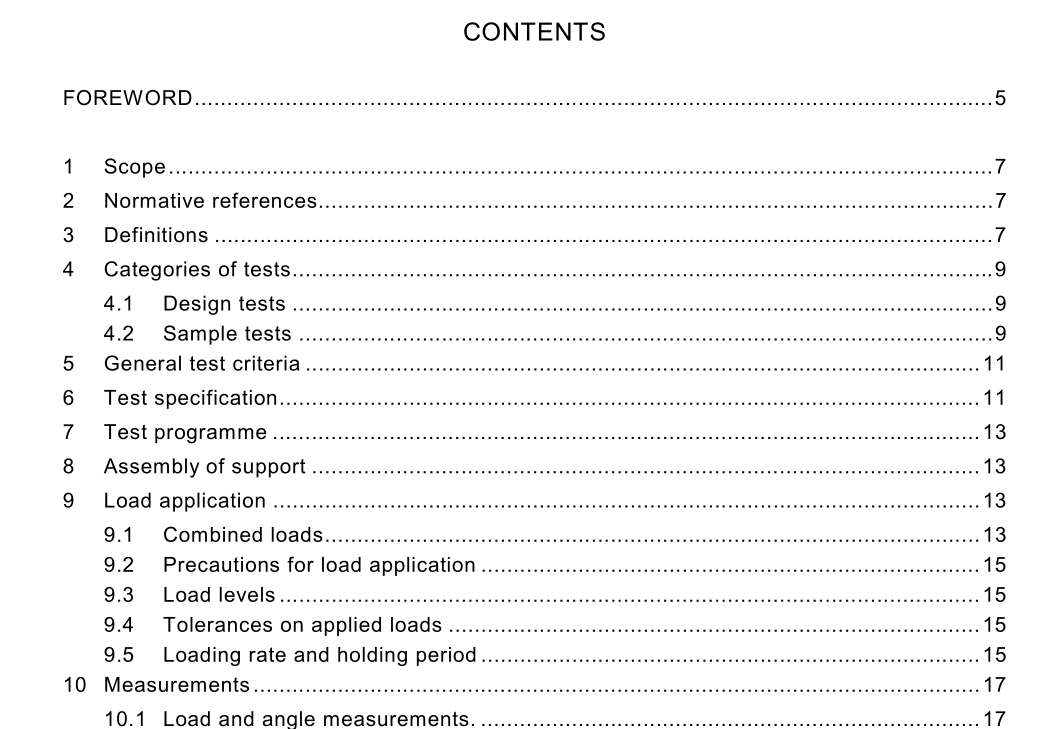IEC 60652 pdf download

IEC 60652 pdf download.Loading tests on overhead line structures
1 Scope
This International Standard codifies the methods of testing supports for overhead lines. It is applicable to the testing of supports and structures of overhead lines for voltages above 45 kV; it can also serve as reference to the testing of lower voltage supports. There is no restriction on the type of material used in the fabrication of the supports which may include, but not be limited to, metallic alloys, concrete, timber, laminated wood and composite materials. If required by the client, this standard may also be applied to the testing of telecommunication supports, railway/tramway overhead electrification supports, electrical substation gantries, street lighting columns, wind turbine towers, ski-lift supports, etc. Tests on reduced scale models of supports are not covered by this standard.
2 Normative references
The following referenced documents are indispensable for the application of this document. For dated references, only the edition cited applies. For undated references, the latest edition of the referenced document (including any amendments) applies. IEC 60050(466):1990, International Electrotechnical Vocabulary (IEV) – Chapter 466: Overhead lines ISO/IEC 17025:1999, General requirements for the competence of testing and calibration laboratories
3 Definitions
For the purposes of this International Standard, the following definitions apply. The definitions listed below supplement those given in lEC 60050(466). 3.1 client organization which contracts with the testing station and provides the test specification 3.2 design load load for which the support has been designed
3.3 failure load point at which the support cannot carry any additional load NOTE It is also known as the limit state failure load and is determined during a destruction test on the support. 3.4 test report document summarizing all the relevant aspects of the tests
4 Categories of tests
With respect to the purpose of the test, the level of instrumentation and the method of execution, this standard refers to two categories of tests: a) design tests; b) sample tests. 4.1 Design tests Design tests are normally carried out on prototype supports, with one or more of the following objectives: a) as part of a research and/or development programme in the design of an innovative support; b) to verify compliance of the support design with the specifications (also known as type tests); c) to develop and/or validate a new design standard or methodology; d) to develop and/or validate new fabrication processes. When tests are carried out to verify design parameters, the test support shall be identical as far as possible to the production supports (see clause 5, first paragraph). Tests on full scale sections or part of the support may also be undertaken. Design tests shall be carried out to at least the design load or to failure, especially when testing according to 4.1b) and/or 4.1c). 4.2 Sample tests These are intended for use either prior to or during the fabrication of the production of a batch of supports to act as a check on the quality of the fabrication, or on the materials being used. The support may be taken at random from the production supports during manufacture. Sample tests are taken to a specific percentage of the design load (usually 100 %), as stipulated in the test specification.
5 General test criteria
For a design test (according to 4.1b) or 4.1c)), the material(s) and the manufacturing processes used in the fabrication of the prototype support shall be to the same specifications as those used during the fabrication of the production supports. These specifications shall include the member sectional properties, connection details, e.g. bolt or weld sizes, material grades and fabrication processes. Prior to the commencement of the prototype support fabrication, agreement shall be made with regard to the surface coating of the support. Agreement shall also be made with respect to the organization responsible for the checking of the support prior to the testing. If a sample test is required on a production support, the components may be chosen at random from the batch. Whether it is for the design test (according to 4.1b)) or the sample test, the support shall successfully withstand the loads specified by the client. If required by the client, the testing station shall be accredited by an external organization to perform this type of test according to the procedures of quality assurance defined by ISO/IEC 17025.









